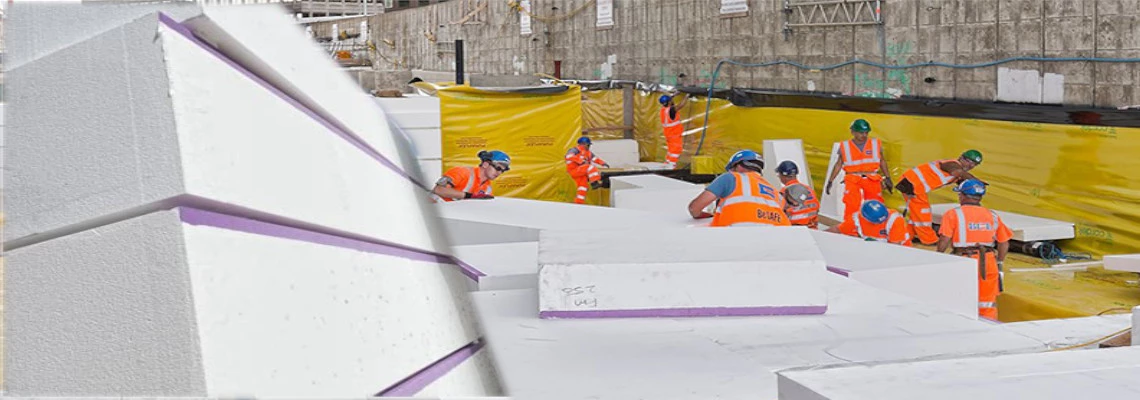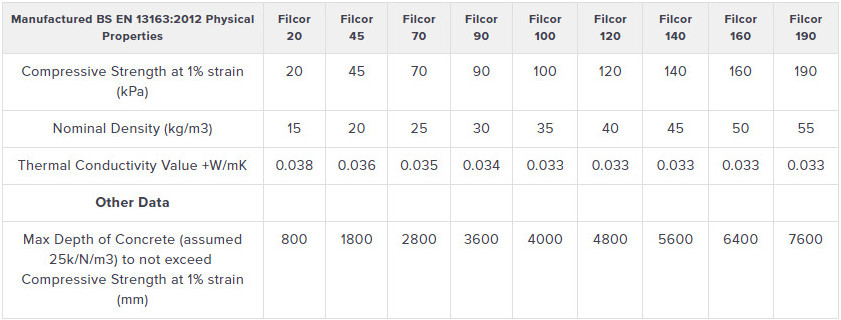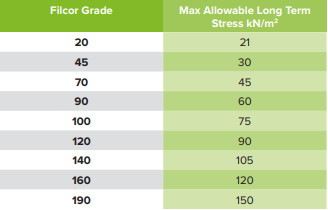
Understanding Filcor. Lightweight structural fill*
Filcor EPS is a type of polystyrene EPS block produced by well known Cordek® company. This close cell product has good structural properties and some inherent insulation properties too.
Filcor (Expanded Polystyrene) is increasingly being specified for an ever-growing range of applications. The most common applications include use as a lightweight structural fill alternative to more traditional fill materials or as a lightweight void former in structural concrete.
The low cost and lightweight of Filcor EPS makes it an ideal void former. Its use reduces the volume of concrete and therefore the weight of the structure.
To understand Filcor we need take closer look at below table.

Filcor works on 1% compression figure. Basically we have all different grades from 20 to 190.
Filcor 20 is the lightest grade.
For example we introduce load od 20 kN/m2 on a field. 100mm deep will compress by one percent of that 100 millimeter depth.
Next line across is the nominal density. That is physically what the product weights in kg/m3. That comes in handy when you are actually selecting the size of sheet or block that you would require per a particular application.
For example Filcor 190 (55 kilograms per cubic meter) is very dense block, so you don’t want to be carrying around a 1.2 by 1.2 meter block of that. Right?
You would consider here to actually have those blocks in 0.6 or less for manual handling.
Next row is a thermal conductivity. That is what the product physically is. Please note this is not the u-value of the product!
The thermal conductivity of Filcor is the rate at which heat energy passes through it and therefore the lower the value the better the material will insulate against heat loss.
If you would like a u-value calculation undertaking we can do that for you here.
Last row-maximum depth of concrete. That is simply how much concrete product will take on top of it for various different grades.
The versatility of Filcor means that any shape, size or profile can be manufactured with relatively short lead times.
In addition, a range of materials of increasing compressive strengths are available to meet the loading requirements of the application, whilst also providing the most cost effective solution.
The long term behavior of Filcor is determined by compressive creep, which relates to the theoretical deformation over time.

Compressive creep will normally be considered for application where continuous high loads are imposed on a structure supported by Filcor, e.g. building foundations, which are subjected to the full design load for extended periods of time.
Polystyrene will never be cheaper than conventional film materials. Why?
The reason that people select polystyrene is for its intrinsic insulation values, the fact that is very adept to profiling, shaping and also because of reduction in the environmental impact.
Filcor vs Fire
All Filcor grades are manufactured with the use of a polymeric Flame Retardant (FR) additive. The addition of the FR additive during the manufacturing process has no detrimental effect on the physical characteristics of the material. The additive is polymerised within the molecular structure of the material and therefore is insoluble, preventing it from leaching out in to its surroundings.
When designing applications involving Filcor, it should be covered by a surface material or layer that has a suitable fire rating. The material / layer initially in direct contact with the fire will determine the overall behavior of the installation in fire conditions.
Based upon the use of an FR additive, Filcor has a Euroclass E rating when tested in accordance with BS EN 13501-1.
Filcor vs chemicals
Filcor is unaffected by water and aqueous solutions of salts, acids and alkalis. The use of adhesives, release agents and other commonly used construction chemicals in conjunction with Filcor should be considered to ensure compatibility prior to use.
The Filcor should be protected from possible contact with petroleum, solvents or hydrocarbons.
Filcor Installation
Filcor should be placed upon a suitable firm and level surface. Typically, a blinding layer comprising of either sand or concrete beneath the panels is recommended. Where the ground conditions do not provide a suitably firm surface, a geotextile layer can be placed on top of the soil before placing the blinding course.
All Filcor blocks are clearly labeled, confirming the product type and dimensions.
The procedure for installing Filcor sheets/blocks is straightforward but the following points should be adhered to:
• Filcor should be positioned on a firm level surface, with joints between individual sheets/blocks, staggered where possible.
• If the depth of Filcor required exceeds the maximum individual sheet/block depth of 1200mm, then further layers can be added to achieve the total depth required. It is suggested that each layer is installed perpendicular to the previous one in order to distribute load as equally as possible.
• Where there is a requirement to cut the Filcor blocks, this can be carried out using a fine toothed saw, or alternatively a hot wire cutter.
The Filcor sheets / blocks in each layer should be ‘butt jointed’, positioned with staggered joints without vertical or horizontal joints running through the installation.
• Any voids between the Filcor and the adjacent face of the excavation, should be filled with a suitably sized, granular fill. This procedure should be carried out as each layer of sheets / blocks is installed to ensure any voids are filled sufficiently.
Storage
All Filcor sheets are delivered in a polythene wrapping and are clearly labeled, however larger blocks are usually delivered without any external packaging and have product information relating to grade and dimensions applied directly to the product.
Both Filcor sheets and blocks can be manually handled and offloaded upon delivery, taking into account any site specific manual handling regulations. Larger blocks of high density
Filcor may require mechanical handling if their weight exceeds manual handling guidelines.
Filcor sheets must not be exposed to flame or ignition. Careful consideration should also be given to the management of fire risk when in storage.
No further storage requirements are needed as the product is unaffected by both UV light and water. Due to the relatively light nature of the product, all Filcor sheets should be weighted down.
*All the information provided in the content published on Insulationgo blog is for informational and educational purposes only. Insulationgo LTD makes every effort to ensure the accuracy and timeliness of the content, but we do not assume any responsibility for any errors or omissions.
The information presented on this blog should not be considered as professional advice or a substitute for consulting relevant experts. Before making any purchase decisions or taking action based on the information presented here, it is strongly recommended to contact the product manufacturer directly to verify the details and ensure its suitability for your specific needs.
By using this blog, you acknowledge and agree that Insulationgo LTD shall not be held liable for any damages, losses, or inconveniences arising from the use or reliance on the information provided herein. This limitation of liability applies to all users of the blog, including but not limited to visitors, readers, and subscribers.










































































































